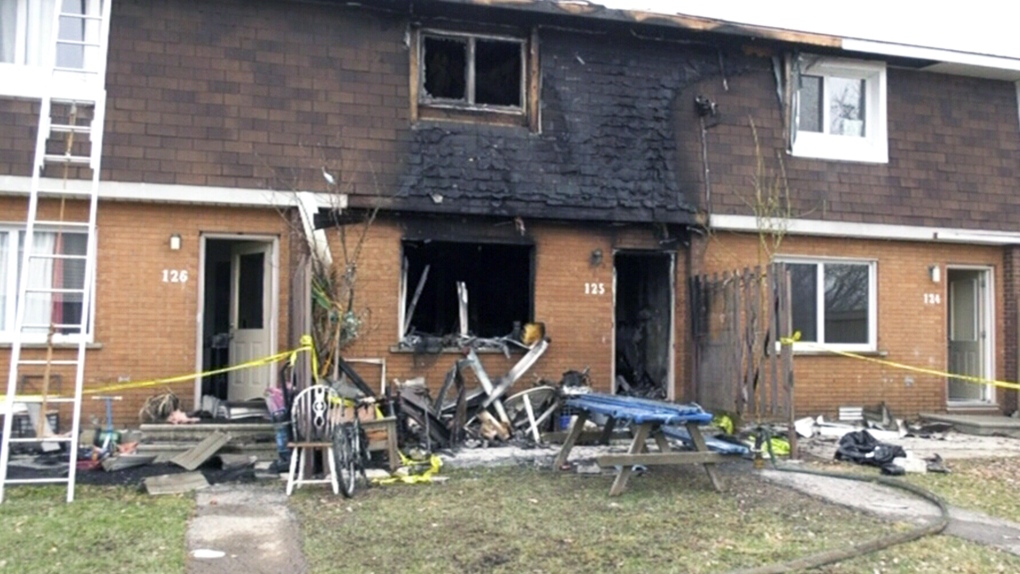How a Sudbury man was convicted of triple murder for orchestrating arson
A Sudbury, Ont., judge has explained why first-degree murder charges against a local man weren't thrown out in a recent fatal arson case, even though the men who actually started the fire had no intention to kill anyone.
Following a six-week trial, Liam Stinson, 27, was found guilty May 3 of first-degree murder in three deaths.
 Three people died in the April 11, 2021, arson: Jasmine Marie-Claire Somers, left, Jamie-Lynn Lori-Lee Rose and Guy Armand Henri. (File)
Three people died in the April 11, 2021, arson: Jasmine Marie-Claire Somers, left, Jamie-Lynn Lori-Lee Rose and Guy Armand Henri. (File)
A fentanyl drug dealer, Stinson admitted he directed two men to throw Molotov cocktails into a Bruce Avenue townhouse on April 11, 2021, at 4:40 a.m., and start a fire inside the kitchen.
Sleeping inside were Jamie-Lynn Rose, Stinson's estranged girlfriend, David Cheff, another drug dealer who lived at the townhouse, Guy Henri and Jasmine Somers.
Only Cheff survived.
At one point during the trial, Justice Dan Cornell rejected a defence application "for a directed verdict of acquittal on all three counts of first-degree murder."
Defence lawyer Joseph S. Wilkinson argued that, while there was evidence that Stinson was responsible for "a planned and deliberate arson … there was no evidence to support a finding of a planned and deliberate murder," Cornell's decision said.
Wilkinson said the two men that Stinson directed to firebomb Cheff's residence only intended to commit arson, not murder.
Since the two men "had no intention to kill, Mr. Stinson can only be found to be an abettor in connection with the arson."
But Cornell accepted the Crown's arguments, made under what's known as the 'innocent agent doctrine,' in which a perpetrator uses someone else to unknowingly commit the crime, in this case, murder.
"In this case, the Crown submits that Mr. Stinson is a principal perpetrator as he committed the offence of first-degree murder by the use of innocent agents," Cornell's decision said.
The 'innocent agents' in his case were the two drug addicts Stinson told to firebomb the townhouse. In exchange, the two men expected to receive 3.75 grams of fentanyl from Stinson.

While they believed they were committing arson in an empty townhouse, Stinson was fully aware there were people inside, Cornell said in his decision, including Rose, his former girlfriend.
Whatever the two drug addicts thought they were doing, Stinson knew that the two Molotov cocktails were being thrown inside an occupied residence.
"The principal in the first degree need not commit the crime with his own hands, he may commit it by a mechanical device or through an innocent agent, or in any other manner, otherwise than through a guilty agent," Cornell wrote, quoting a legal text.
Evidence presented during the trial showed that before the fire, "Mr. Stinson made specific death threats. This was direct evidence available to the jury on the question of intent."
Stinson had exchanged text messages with Cheff and Henri a few hours before the fire, showing he knew people were in the townhouse.
Stinson also gave Rose drugs that night to bring back to the townhouse to deliver to Cheff and Henri – drugs she ended up keeping for herself, something that had happened before.
He also misled the two drug addicts into thinking the townhouse was empty, even showing one of the men a text that appeared to say that Rose was in Timmins for the weekend.
Other evidence presented at the trial showed that Rose feared for her safety.
"Mr. Cheff testified that some months prior to the fire, Ms. Rose showed him a text message from Mr. Stinson to her, telling her to come home, otherwise he would kill her," Cornell's decision said.
"After taking up residence with Mr. Cheff, Ms. Rose had a telephone conversation with her mother approximately two or three weeks prior to the fire. Ms. Rose's mother urged her to return to her home in the Timmins area. Ms. Rose responded by telling her mother that Mr. Stinson had told her that if she left Sudbury, he would kill her mother, father and her children."
Because of these threats, she told her mom that she had to "remain in Sudbury for a few weeks until 'things cooled down.'"
"It was against this evidentiary background the Crown put forward as motive that Mr. Stinson wanted to kill Ms. Rose because he was angry that she had left him and because of the drug debts created by the drugs stolen by her," Cornell wrote.
"There was direct evidence from (the two drug addicts) that they never intended to cause the death of anyone, rather they thought that they were firebombing Mr. Cheff's unoccupied residence in order to obtain drugs from Mr. Stinson. This was evidence for the jury to consider on the question of their innocent 'instrumentality' in so far as murder was concerned."
Because there was indirect and direct evidence that Stinson wanted to commit murder by using the two drug addicts as his agents, Cornell said he rejected the defence request to throw out the charges.
"As these reasons were drafted after the jury returned its verdicts, I am able to note that Mr. Stinson was found guilty of first-degree murder in connection with the deaths of Ms. Rose, Mr. Henri and Ms. Somers," his decision said.
Read the full decision.
 Liam Stinson, 27, iwas found guilty of three counts of first-degree murder and one count of recklessly causing damage by fire in an April 11, 2021, arson that killed three people in a Bruce Avenue townhouse. (File)
Liam Stinson, 27, iwas found guilty of three counts of first-degree murder and one count of recklessly causing damage by fire in an April 11, 2021, arson that killed three people in a Bruce Avenue townhouse. (File)
CTVNews.ca Top Stories

B.C. teen with Canada's first human case of avian flu in critical condition, Dr. Bonnie Henry says
The teenager who is sick with the first-ever human case of avian influenza acquired in Canada is in hospital in critical condition, provincial health officer Dr. Bonnie Henry said Tuesday.
Alleged serial killer previously pled guilty to 2018 attack on Waterloo, Ont. bus
The woman accused of killing three people in three days in three Ontario cities also previously admitted to attacking strangers on buses in the Region of Waterloo.
Here's why thieves may be stealing butter in Canada
The case of the missing butter remains a mystery, but some have ideas on what's behind the unusual crimes.
Former B.C. premier John Horgan dies at 65
Former B.C. premier John Horgan, a popular leader renowned for his affable personality and dedicated public service, has died
Body found in Montreal park identified as cryptocurrency influencer
The body of a man that was found in a park in the Ahunstic-Cartierville borough last month has been identified as cryptocurrency influencer Kevin Mirshahi.
Elon Musk and Vivek Ramaswamy will lead new ‘Department of Government Efficiency’ in Trump administration
President-elect Donald Trump announced Tuesday that Elon Musk and Vivek Ramaswamy will lead a new “Department of Government Efficiency” in his second administration.
Air Canada to add new routes to U.S., Europe and North Africa in summer 2025
Getting to destinations in the U.S., Europe and North Africa is about to get easier, as Air Canada announced it will be increasing flights to a number of new destinations this summer.
History in Halifax is slowly being wiped off the map: study
Saint Mary's University archeologist Jonathan Fowler is sounding an alarm with a new study. According to Fowler, the centuries-old architecture that adds to Halifax’s heritage and historic vibe is slowly being wiped away as the city grows.
2-year-old gorilla 'Eyare' dies unexpectedly at Calgary Zoo
A young gorilla at the Calgary Zoo has died. The Wilder Institute/Calgary Zoo announced a member of its western lowland gorilla troop passed away unexpectedly, in a news release Tuesday.

































